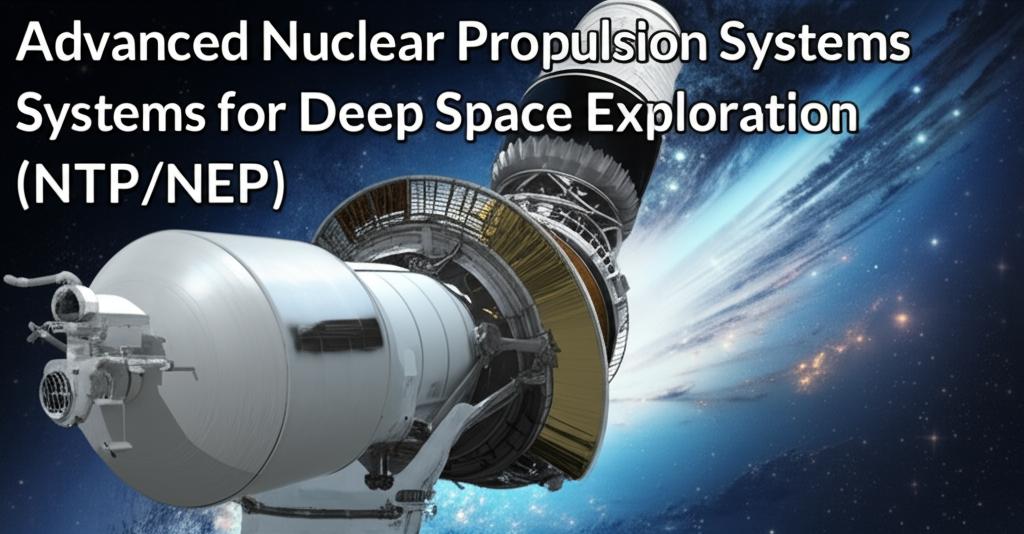Venturing into the vastness of deep space, reaching destinations like Mars and the outer planets efficiently and safely, demands propulsion technologies far exceeding the capabilities of conventional chemical rockets. Advanced nuclear propulsion systems, primarily Nuclear Thermal Propulsion (NTP) and Nuclear Electric Propulsion (NEP), represent the forefront of this technological leap, promising faster transit times, greater payload capacity, and enhanced mission flexibility.
Nuclear Thermal Propulsion (NTP) operates by using a fission reactor to heat a liquid propellant, typically hydrogen, to extremely high temperatures (around 2500-2700 K or higher). This superheated hydrogen gas is then expelled through a nozzle, generating powerful thrust. NTP systems offer significantly higher efficiency than chemical rockets, roughly doubling the specific impulse (a measure of engine efficiency). This translates to the potential to cut Mars transit times by 25% or more, reducing crew exposure to harmful space radiation and lessening the logistical burden of long-duration missions. NTP provides high thrust, making it suitable for rapid maneuvers like escaping Earth's orbit or entering Mars orbit. Current efforts, like the collaboration between NASA and DARPA on the Demonstration Rocket for Agile Cislunar Operations (DRACO) program, aim to test an NTP system in space, potentially as early as 2027, although ground testing and integration challenges are being addressed. Companies like Lockheed Martin, General Atomics, and BWX Technologies are actively involved in developing reactor designs and testing advanced nuclear fuels capable of withstanding the extreme conditions within an NTP reactor. Recent tests have successfully demonstrated fuel element resilience at temperatures up to 2600-3000 K under hot hydrogen flow.
Nuclear Electric Propulsion (NEP), on the other hand, utilizes a nuclear reactor to generate substantial amounts of electricity. This electricity then powers highly efficient electric thrusters, such as ion or Hall-effect thrusters, which ionize and accelerate propellant (like xenon or krypton) to very high exhaust velocities. While NEP systems produce much lower thrust compared to NTP or chemical rockets, they boast exceptionally high specific impulses, potentially 5 to 10 times greater than chemical rockets. This unparalleled efficiency allows NEP systems to operate continuously for extended periods, making them ideal for long-duration cargo missions, journeys to the outer solar system where solar power is impractical, or missions requiring significant onboard power for instruments and communications. Concepts like Radioisotope Electric Propulsion (REP), using heat from radioactive decay, are proven but lower power (~1 kW), suitable for small probes like Voyager. Fission Electric Propulsion (FEP) uses reactors for higher power (potentially 10s to 100s of kW or even megawatts), enabling more ambitious missions. Challenges for high-power NEP include managing waste heat, requiring large radiator systems (like NASA Langley's MARVL concept exploring modular, in-space assembled radiators), and scaling power conversion technologies.
Comparing the two, NTP offers high thrust and moderate efficiency gains (ideal for faster crewed missions), while NEP provides low thrust but exceptional efficiency (suited for cargo or very long-distance robotic exploration). The choice depends heavily on the specific mission requirements. Both systems significantly outperform chemical rockets for deep space travel.
The push for nuclear propulsion stems from its numerous advantages: substantially shorter trip times (potentially reducing a Mars round trip to about two years), increased payload capacity for supplies and scientific equipment, the ability to provide robust power for spacecraft systems far from the Sun, and enhanced mission flexibility, including wider launch windows and abort capabilities.
Current initiatives involve significant collaboration between government agencies like NASA, the Department of Energy (DOE), and DARPA, alongside industry partners. Besides propulsion, NASA is also developing Fission Surface Power concepts for providing sustainable energy on the Moon and Mars. While the technology holds immense promise, challenges remain. These include the initial cost and mass of nuclear systems, the need for robust radiation shielding for crews and components, developing materials that can withstand extreme temperatures and radiation, managing heat dissipation effectively, and gaining more operational experience, particularly with high-power NEP systems. Safety protocols are paramount, ensuring reactors are only activated in safe orbits far from Earth.
Despite these hurdles, the development of advanced nuclear propulsion is accelerating. Ongoing research, technological demonstrations like DRACO, and advancements in materials science and reactor design are paving the way for these systems to become operational. Nuclear propulsion is widely regarded as a key enabling technology that could revolutionize space exploration, making ambitious missions to Mars, the outer planets, and potentially even interstellar space a tangible reality in the coming decades.

